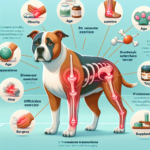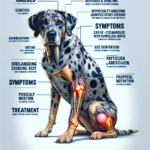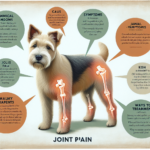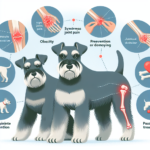Chinese Shar-Pei Joint Pain: Causes, Symptoms, Prevention, and Treatment
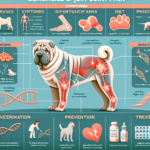
Introduction
The Chinese Shar-Pei is a distinctive and ancient breed known for its deeply wrinkled skin and unique appearance. Originating from China, the Shar-Pei was initially bred for hunting, herding, and guarding. The breed’s name translates to “sand skin,” referring to its rough, short coat. Shar-Peis are medium-sized dogs, typically weighing between 40 to 55 pounds, and are known for their loyalty, intelligence, and independence.
While the Chinese Shar-Pei is a robust and resilient breed, it is not without its health concerns. Common issues include skin problems, eye conditions, and joint pain. Joint health is particularly crucial for this breed due to its predisposition to certain joint-related ailments. Ensuring the well-being of a Shar-Pei’s joints can significantly enhance their quality of life and longevity.
Breed-Specific Joint Pain Risks
Genetic Predisposition
The Chinese Shar-Pei is genetically predisposed to several joint-related issues, including hip dysplasia, elbow dysplasia, and arthritis. Hip dysplasia is a condition where the hip joint does not fit properly into the hip socket, leading to pain and mobility issues. Elbow dysplasia involves abnormal development of the elbow joint, causing lameness and discomfort. Arthritis, a degenerative joint disease, is also common in Shar-Peis, leading to chronic pain and stiffness.
Age-Related Risks
As Shar-Peis age, the risk of developing joint pain increases. Typically, signs of joint issues may start to appear in middle age, around 5 to 7 years old. However, some dogs may show symptoms earlier, especially if they have a genetic predisposition. It’s essential for owners to monitor their Shar-Pei’s joint health as they age and to be aware of any changes in mobility or behavior.
Activity Level and Joint Stress
Shar-Peis are moderately active dogs that enjoy regular exercise. However, their activity level can contribute to joint stress, especially if they engage in high-impact activities like jumping or running on hard surfaces. While exercise is crucial for maintaining overall health, it’s important to balance activity levels to prevent excessive strain on the joints.
Common Symptoms of Joint Pain in Chinese Shar-Pei
General Symptoms
- Limping or favoring one leg
- Stiffness, especially after rest
- Reluctance to move or climb stairs
- Decreased activity or playfulness
- Swelling around the joints
- Whining or showing signs of discomfort when touched
Breed-Specific Symptoms
In addition to general symptoms, Shar-Peis may exhibit breed-specific signs of joint pain. Due to their unique skin folds, they might show discomfort through excessive licking or chewing at the affected area. Additionally, their characteristic gait may become more pronounced or altered when experiencing joint pain.
When to Consult a Vet
If you notice any of the above symptoms in your Shar-Pei, it’s crucial to consult a veterinarian promptly. Early diagnosis and intervention can significantly improve the prognosis and quality of life for dogs with joint pain. Regular veterinary check-ups are also essential for monitoring joint health and catching any issues early.
Preventive Measures for Joint Health
Exercise Recommendations
Regular, low-impact exercise is vital for maintaining joint health in Shar-Peis. Activities such as walking, swimming, and gentle play can help keep joints flexible and muscles strong without causing excessive strain. Avoid high-impact activities like jumping or running on hard surfaces, which can exacerbate joint issues.
Dietary Suggestions
A balanced diet rich in essential nutrients can support joint health. Consider incorporating foods or supplements that contain glucosamine, chondroitin, and omega-3 fatty acids, which are known to promote joint health and reduce inflammation. Consult your veterinarian for specific dietary recommendations tailored to your Shar-Pei’s needs.
Weight Management
Maintaining a healthy weight is crucial for reducing joint stress. Excess weight can exacerbate joint pain and lead to further complications. Monitor your Shar-Pei’s weight and adjust their diet and exercise routine as needed to ensure they stay within a healthy weight range.
Early Screening and Monitoring
Regular veterinary check-ups and early screening for joint issues can help catch problems before they become severe. Your veterinarian may recommend specific tests, such as X-rays or joint fluid analysis, to assess joint health. Early intervention can significantly improve outcomes for dogs with joint pain.
Treatment Options for Joint Pain
Non-Surgical Treatments
Non-surgical treatments for joint pain in Shar-Peis include medications, physical therapy, and lifestyle adjustments. Anti-inflammatory medications and pain relievers can help manage symptoms, while physical therapy can improve mobility and strengthen muscles. Lifestyle adjustments, such as providing a comfortable bed and avoiding high-impact activities, can also alleviate joint pain.
Surgical Options
In severe cases, surgical intervention may be necessary. Common surgeries for joint pain include hip replacement, elbow surgery, and arthroscopy. These procedures can significantly improve mobility and reduce pain, but they come with risks and require a thorough discussion with your veterinarian.
Alternative Therapies
Alternative treatments like acupuncture, hydrotherapy, and massage can also benefit Shar-Peis with joint pain. Acupuncture can help reduce pain and inflammation, while hydrotherapy provides low-impact exercise that strengthens muscles without stressing the joints. Massage can improve circulation and alleviate muscle tension.
Lifestyle and Management Tips
Daily Care Routine
A consistent daily care routine can help manage joint pain in Shar-Peis. This routine might include gentle exercise, administering medications or supplements, and providing a comfortable resting area. Regular grooming and monitoring for any changes in mobility or behavior are also essential.
Modifying the Home Environment
Making your home more comfortable for a dog with joint pain can significantly improve their quality of life. Consider adding ramps to help them navigate stairs, providing orthopedic beds for better support, and ensuring their living area is free of obstacles that could cause injury.
Long-Term Management
Long-term management of joint pain involves regular veterinary check-ups, ongoing monitoring of symptoms, and adjusting treatment plans as needed. Keeping your Shar-Pei active and engaged with appropriate activities can help maintain their overall well-being and happiness.
FAQs About Chinese Shar-Pei and Joint Pain
What are the early signs of joint pain in a Chinese Shar-Pei?
Early signs of joint pain include limping, stiffness, reluctance to move, and decreased activity. If you notice any of these symptoms, consult your veterinarian for a thorough evaluation.
Can diet help prevent joint pain in Shar-Peis?
Yes, a balanced diet rich in essential nutrients like glucosamine, chondroitin, and omega-3 fatty acids can support joint health and reduce inflammation. Consult your veterinarian for specific dietary recommendations.
Is exercise important for a Shar-Pei with joint pain?
Yes, regular, low-impact exercise is crucial for maintaining joint health and mobility. Activities like walking and swimming can help keep joints flexible and muscles strong without causing excessive strain.
When should I consider surgery for my Shar-Pei’s joint pain?
Surgery may be necessary in severe cases where non-surgical treatments are ineffective. Consult your veterinarian to discuss the risks and benefits of surgical options for your Shar-Pei.
Are there alternative therapies for managing joint pain in Shar-Peis?
Yes, alternative therapies like acupuncture, hydrotherapy, and massage can benefit Shar-Peis with joint pain. These treatments can help reduce pain, improve mobility, and enhance overall well-being.
Conclusion
Joint pain is a common concern for Chinese Shar-Peis, but with proper care and attention, it can be managed effectively. By understanding the breed-specific risks, recognizing early symptoms, and implementing preventive measures, owners can significantly improve their Shar-Pei’s quality of life. Regular veterinary check-ups, a balanced diet, appropriate exercise, and a comfortable living environment are essential for maintaining joint health. If joint pain becomes severe, consult your veterinarian to explore treatment options, including non-surgical and surgical interventions. With the right approach, your Shar-Pei can enjoy a happy, active life despite joint pain.

